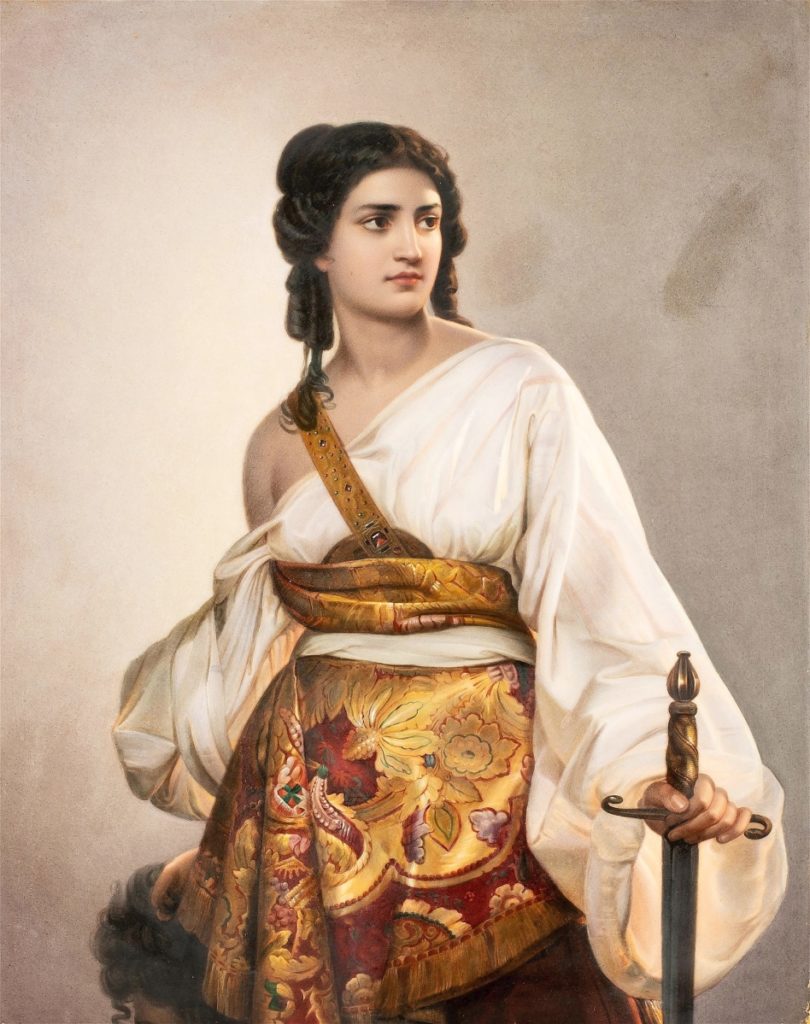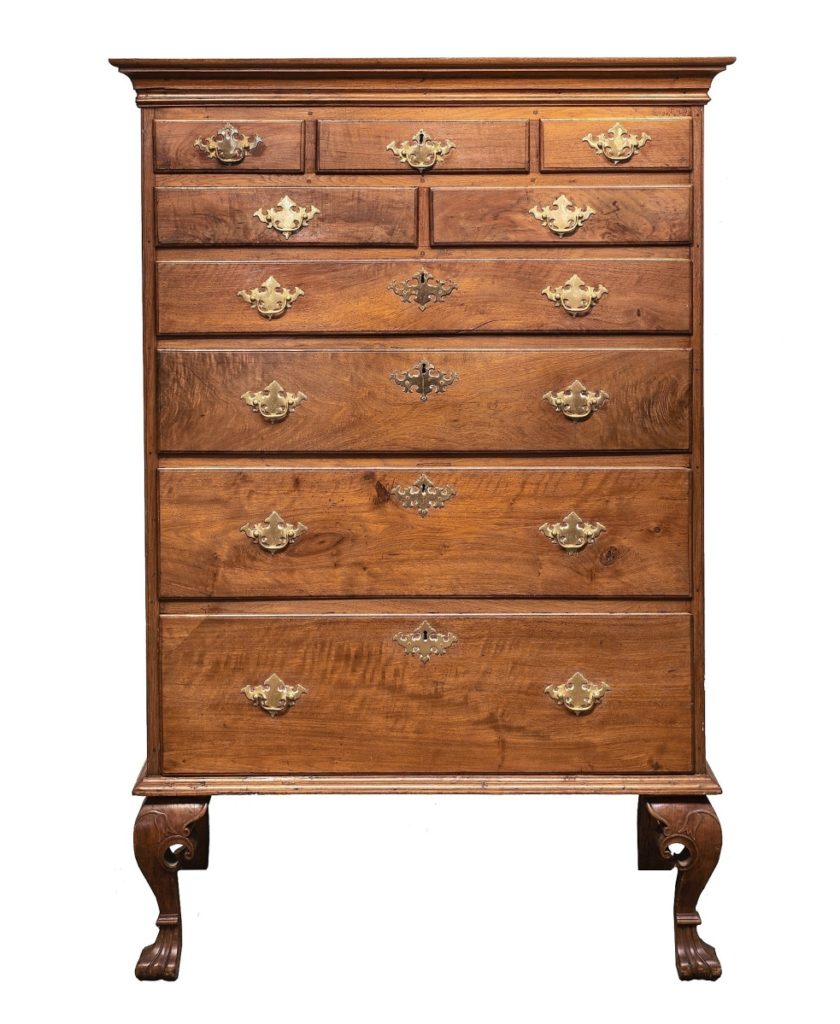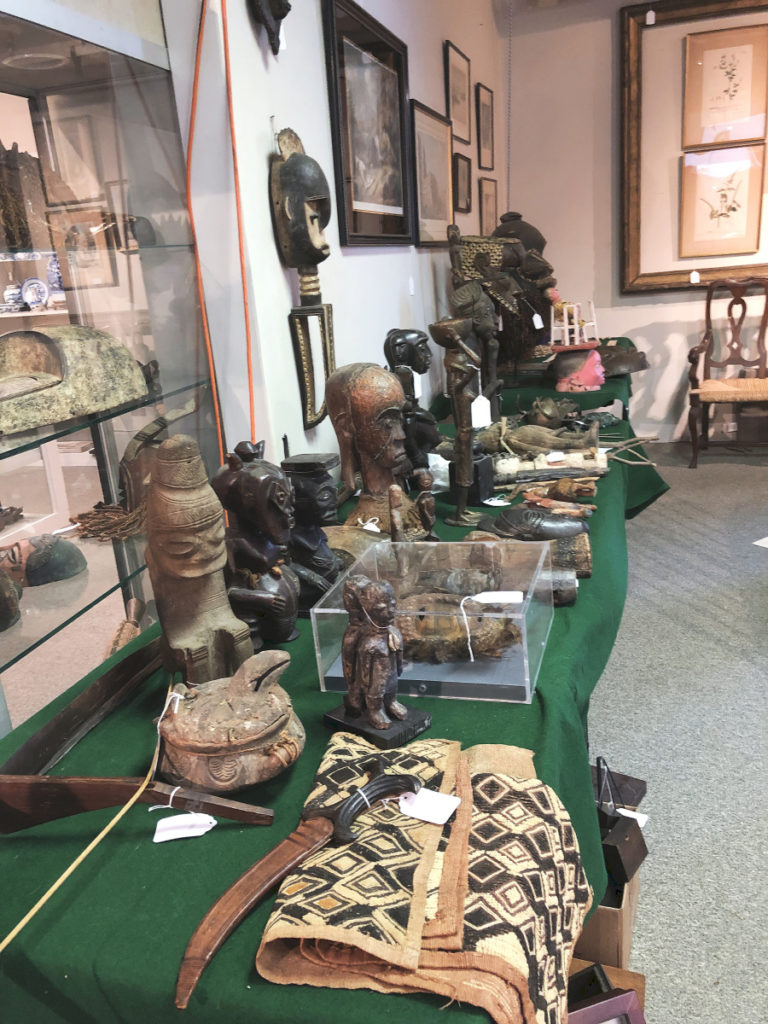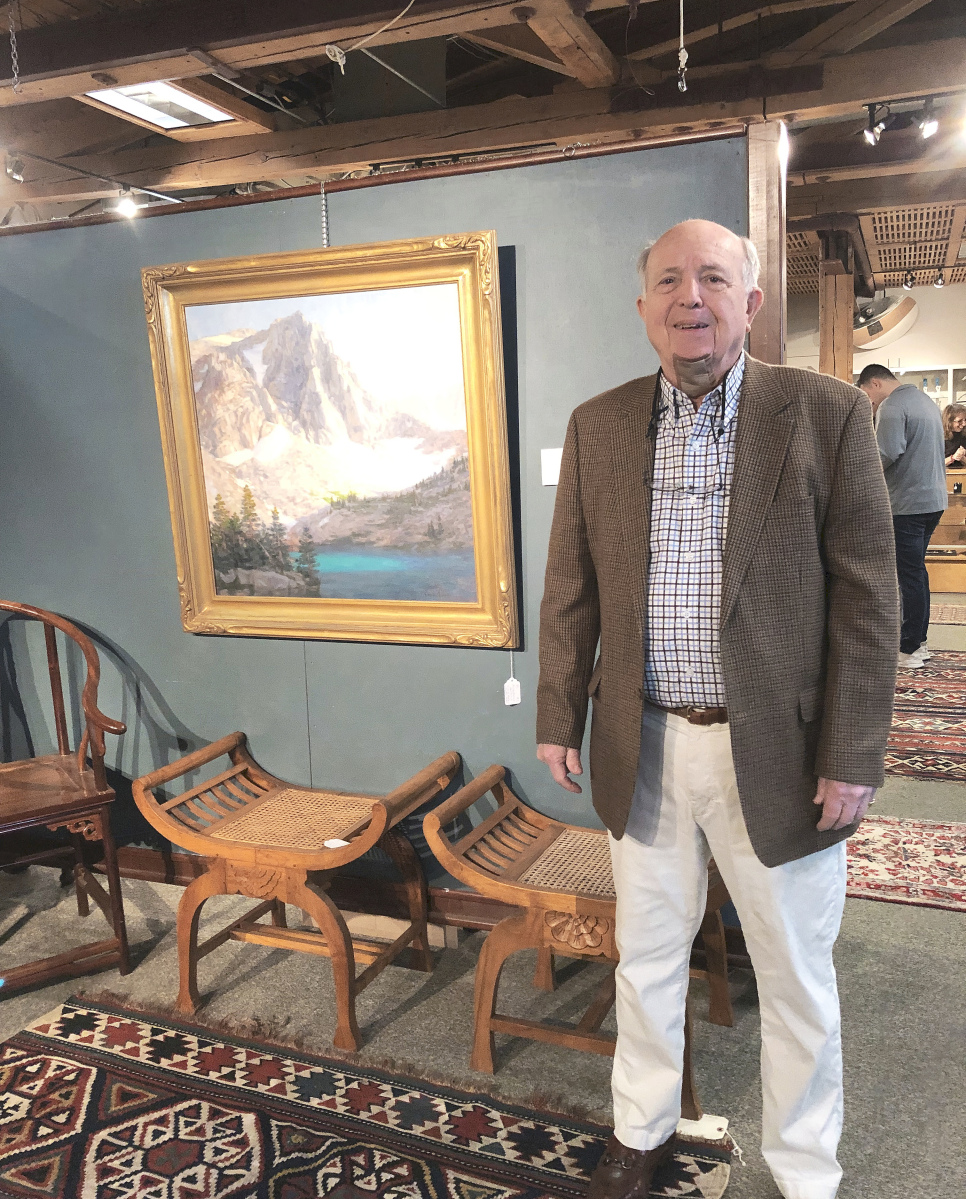
In the original frame, this marked KPM portrait plaque earned $6,600.
Review & Onsite Photos By Rick Russack, Additional Photos Courtesy The Cobbs
PETERBOROUGH, N.H. – Charlie and Dudley Cobb have been in the antiques business since 1967 and have been conducting auctions since the 1980s, becoming full-time auctioneers in 1987. The company specialized in Nineteenth Century and earlier Americana, much of it sourced from local estates. The April 30 sale, grossing about $200,000, was their last, with gallery fixtures and their extensive research library included in the sale.
It’s ironic in a way that for a company that loved and concentrated on Nineteenth Century American antiques that the highest priced item in its final sale would be a mid-Twentieth Century painting by an Indian artist. But that’s what happened. The painting, described in the catalog as “an Indian painting of a man playing a stringed instrument” with an illegible signature, sold for $48,000. The primary interest in the painting came from India, and it’s a strong possibility that the “illegible signature” was that of S.H. Raza (1922-2016), one of India’s most prominent painters and winner of numerous awards. The Cobbs decided not to mention that name, gave it a very low estimate and let the marketplace decide its worth. Bidding began at $5,000 and moved slowly to the final $48,000 price. To say that it was a pleasant surprise to the Cobb family, as well as the 50-60 people in the gallery, would be an understatement.

The highest priced piece of furniture in the sale was this Pennsylvania walnut Queen Anne tall chest that brought $10,800. It retained its original brasses, had an old refinished surface and some unusual construction details.
The sale included a number of other paintings, firearms and jewelry that did well, and it was a Pennsylvania walnut Queen Anne tall chest that brought the second highest price of the day, $10,800. From Chester County, with three-over-two-over-four graduated drawers, it retained its original brasses and had an old refinished surface. The construction was unusual and was described in the catalog as “the original frame consists of two front to back slats with wooden nuts and bolts attaching it to the underside of the chest, each leg is then attached to the slat.” The knees were carved with bellflowers.
Other artwork included an unsigned portrait attributed to Sir Joshua Remolds (1723-1792), based on an old paper label on the reverse, which said “Marquis of Granby Painted by Sir Joshua Reynolds.” It had some condition problems and sold for $7,800. There were also two scenes of the American West by Charles Muench, (b 1966), One was titled “Sienna Backcountry Lake” in the Sierra Nevada Mountains. The title of the other was “Sunrise, Kearsarge Lakes,” also in the Sierra Nevada Mountains. Each had been bought by the consigner directly from the artist and each sold for $4,200. The artist’s gallery today is in Nevada, in those mountains. A Nineteenth Century portrait of an attractive woman on a KPM porcelain plaque earned $6,600. A large thangka Tibetan silk painting depicting a central seated Buddha, surrounded by numerous small Buddhas, earned $5,100.

At $6,600, this Dublin Castle Brown Bess flintlock musket, circa 1750-90, was the highest priced firearm in the sale. These weapons were the primary British military long arms from 1722 to 1854, and most were made at the Tower of London. This example was marked on the lock plate “Dublin Castle” and was also marked “GR” for George Rex.
This sale had an interesting selection of firearms. Leading the offerings was a Dublin Castle Brown Bess flintlock musket, circa 1750-90. These weapons were the primary British military long arms from 1722 to 1854, and most were made at the Tower of London. This example was marked on the lock plate “Dublin Castle” and also marked “GR.” It reached $6,600. An example of the first mass-produced musket manufactured by a US national armory realized $1,560. It was a model 1795 Springfield type 1 flintlock musket, designed by Eli Whitney, and was dated 1806 on the butt plate. An interesting piece of history in good condition realized $720. It was an 1861 US percussion rifle, altered and decorated by a Native American tribesman. This rifle was made by J.T. Hodge and A.M. Button at the Trenton Locomotive and Machine Company under contract to the federal government. The lock plate is marked 1865. After the Civil War, weapons such as this, used to fight Native Americans, were issued to US military units stationed at frontier forts. Often, after a battle, weapons were picked up on the battlefield by the Native American and modified by them to fit their needs, such as shortening the barrel for use on horseback. This example had a shortened 15¾-inch barrel. Native Americans often decorated their prizes with tacks, and in this case, 70-star head tacks were hammered into the stock. These tacks were readily available at frontier trading posts.
The firearms selection also included a small collection of “muff pistols.” These small pistols were designed to be concealed in women’s hand-warming muffs for protection against highwaymen while riding in carriages. An engraved, circa 1800 pair of European flintlock pistols, with 2½-inch barrels went out for $660. There were additional examples.

A portion of the ethnographic items on display prior to the auction.
As mentioned, Cobb included showcases and fixtures in this sale. Most went quite reasonably, but he had trouble finding a buyer for one, a large, two-part wooden gun case. The catalog estimate was $60-$100. Cobb did not get an opening bid at $30. Nor at $20, nor at $10. He finally said “it’s gotta go – I’ll pay whoever takes it away $5.” That worked, he found a willing “buyer” and said, “That’s only the second time in my career I’ve had to pay someone to take something away.”

Charlie Cobb stands next to one of the two Muench paintings, while busy talking with well-wishers and old friends.
A few days after the sale, Cobb reminisced about his decades in the business.” My wife and I were antiques dealers long before the auctions began. When business slowed down, some of the other dealers I knew asked me to do a couple of auctions. Stuff wasn’t selling in shops, but the auctions worked. So that’s when our family – we’ve always been a family business – discussed what direction we should be taking, and everyone agreed that auctions were the way to go. So I bought this building and our whole approach changed. As soon as the internet became a “thing,” we started with a website for the auctions and there was no going back. We were one of the first to get on board with the internet. We were doing business with people all over the country, and later, all over the world. The Indian painting that did so well in this sale is a perfect example – in the old days, that might have sold for a few hundred dollars to a dealer in the room. Now people all over the world can see things like that and the results speak for themselves. The days of people coming to an auction, bidding on what they liked, paying for it and taking it home were gone. Now we had to learn how to deal with absentee and phone bids. That was all new. I figured that if the New York auction houses could do it, so could we. My biggest worry at the beginning was about being sure that we’d get paid. But it all worked out. What I’ve missed most lately is that we don’t get the crowds we used to get. I like people; I really enjoyed meeting people and making new friends. It was a good life, and we had a lot of fun. But now that we’ve sold everything, Dudley and I are looking forward to a new way of life and we’ll enjoy that, too.” Charlie is now 82, and they plan to enjoy retirement, residing in a spacious apartment in the large, historic Noone Mill building in Peterborough, which they restored. Nick Prior and Molly Williams, two knowledgeable longtime employees, have decided to continue in the auction business, forming a company, Peterborough Auctions, which will continue to do business in The Cobbs building but not in the same space.
Prices given include the buyer’s premium as stated by the auction house. For information, www.thecobbs.com or 603-924-6361.





























